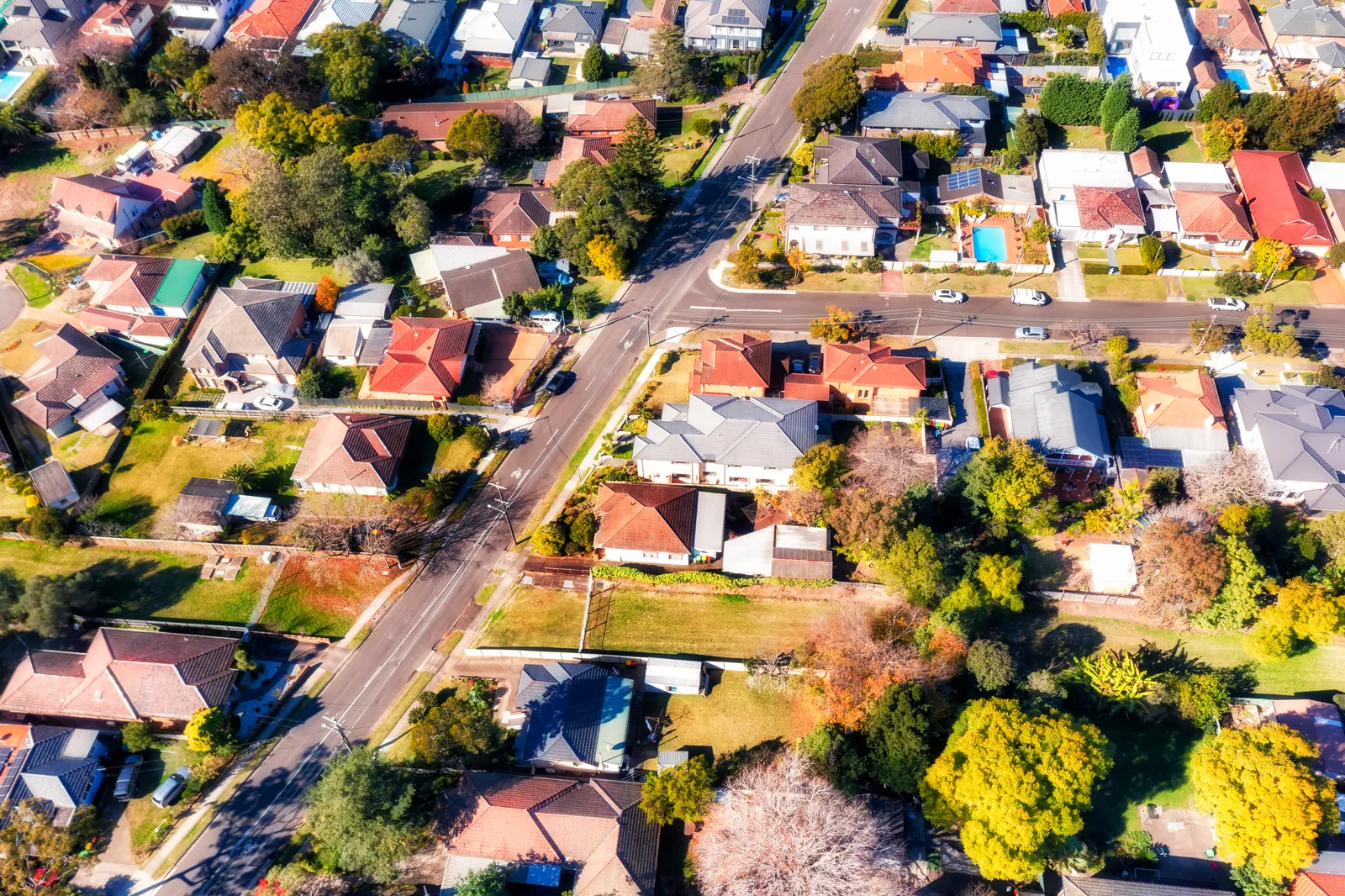
The overwhelming consensus is the Reserve Bank is likely nearing the end of its tightening cycle and that mid-term supply and demand fundamentals remain imbalanced.
While buyer demand is softer of late, the number of Australians looking to buy a home remains elevated.
And despite a fall in the number of new for-sale listings, the supply of dwellings across the country remains constrained.
What’s happening with prices?
Home prices have fallen in recent months and are expected to cool further throughout this year, but they remain significantly higher than pre-Covid levels.
At a national level, property values are down 4.51% from their March 2022 peak.
PropTrack director of economic research Cameron Kusher said values at a national level are projected to fall 7% to 10% in 2023.
However, home prices nationally surged by 34.7% from the start of the pandemic to the peak in March last year.
So, even if prices fall at the highest range of the forecast, national home values will still be a staggering 18% higher than they were pre-Covid, he said.
Some cities are also set to fare better than others, with secondary capitals forecast to see smaller dips in home prices.
Maree Kilroy is a senior economist at BIS Oxford Economics and said the pace of home price falls has clearly slowed in recent times.
Broadly, Ms Kilroy expects home prices will likely continue to soften for several months as the lagged impact of rate hikes flows through to the market.
But the price correction might be short-lived, she said.
“Our forecast is for the September quarter to represent the bottom for national property prices, with turnover beginning to improve soon after,” Ms Kilroy predicted.
“But some cities will recover earlier than others.”
The outlook for interest rates
Price falls have been driven predominantly by the Reserve Bank’s rapid interest rate hikes, in a bid to crush red-hot inflation.
Mr Kusher said one or two further rate hikes of 25 basis points are expected, and “thereafter we expect rates to remain on hold”.
And there’s potential for the RBA board to even begin cutting the cash rate again in late 2023 or early 2024, he said.
“We anticipate these further interest rate rises will push prices lower. However, a lower interest rate peak and earlier-than-expected interest rate cuts could ease price falls.”
The annual rate of inflation in December was 7.8%, which was the highest level seen in decades, however, the quarterly measure was a little softer than expected.
Production costs have also eased, Mr Kusher said, adding more glimmers of hope on the horizon that extremely high inflation is finally being contained.
There are signs that consumer spending is coming off the boil, with NAB data released last week showing Aussies are making “thoughtful” budget adjustments.
Rachel Slade, the bank’s personal banking group executive, said four-in-10 consumers have reduced spending on entertainment, lunches and coffees, and cut the number of car trips they made.
Another third of consumers have scaled back holiday plans, cut back on spending on food delivery apps, or delayed a major household appliance purchase.
“Australians are now making small but thoughtful changes to their purchases to keep on top of increasing costs,” Ms Slade said.
Meanwhile, Ms Kilroy said she expects the RBA’s rate tightening cycle to “top out soon”, with the cash rate likely to peak at 3.6% in March before holding steady.
Another leading economist has also predicted one more rate rise this year, before the RBA sits on a cash rate of 3.6% to monitor the impact of rapid hikes on the economy.
HSBC chief economist Paul Bloxham delivered the forecast at a meeting of the Financial Services Institute of Australasia ahead of the first meeting of the RBA board of 2023.
“In my view, the RBA [will] lift a bit further and then they’re going to stop for a while, but I’m not completely convinced that the next move will then be down anytime soon,” Mr Bloxham said.
Meanwhile, Gareth Aird, head of economics at CBA, expects a further two rate raises from now of 25 basis points each.
“This would take the cash rate to 3.85%,” Mr Aird said, tipping hikes in March and April.
Mid-term fundamentals sound
Speaking at an event hosted by real estate prop-tech company AltX in early February, demographer Bernard Salt said homeowners and investors had reason to feel optimistic.
A significant resumption in migration, comprising both foreign students and skilled workers, will see a flood of new arrivals searching for properties, particularly in inner-city suburbs.
Analysis by PropTrack shows a jump in activity on realestate.com.au from overseas-based house hunters.
Rent searches on realestate.com.au from abroad in 2022 increased by 65% compared to 2021 and were 20% higher than pre-pandemic levels in 2019. Buy searches were up 10% compared to 2021 and 11% higher than 2019 levels.
As well as demand from foreigners, Mr Salt said longer-term demographic shifts will also underpin housing demand, particularly as mid-life Millennials start families and upsize.
“We’re about to see five-and-a-half million people pass from the single apartment stage into needing a lifestyle house,” Mr Salt said.
The home-building sector was hit by a perfect storm of factors in 2022, including surging materials costs, supply chain disruptions, and labour shortages.
As a result, the number of residential construction commencements fell off a cliff and approvals declined sharply.
While there are growing signs of a recovery on the horizon, it will take time for the industry to catch up, meaning the number of new homes being built will be soft.
Supply of new dwellings is already insufficient to keep up with demand.
Still plenty of buyers around
Across the capital cities, the number of highly engaged potential buyers browsing realestate.com.au slipped by a fairly modest 4.6% in 2022.
“But that measure remains much higher than pre-pandemic levels,” Mr Kusher said.
Buyer activity is softer than it was in 2021, but that boom period saw an almost unprecedented level of frenzied activity across virtually all of Australia, he said.
The median length of time a home is listed on realestate.com.au before selling has also lifted, from 32 days in December 2021 to 42 days in December 2022.
Again, markets at the end of 2021 were operating at historic speeds and at that time on site figure was a record low, so the decline is to be expected.
‘Scary’ figures put in context
The latest lending data from the Australian Bureau of Statistics points to caution among homebuyers, with a 4.3% decline in total loan commitments in December.
Although, as Real Estate Institute of Australia boss Hayden Groves pointed out, that’s a rather modest dip from the record-high peak seen in early 2022.
“The downward adjustment coincides with falls in retail spending as inflation and interest rates continue to rise,” Mr Groves said.
Both owner-occupier and investor loans have softened from last year’s highs as Australians adopt a “watch and wait” approach to property, he added.
“In December 2022, the value of total new loan commitments was 23% higher than the level seen in February 2020, prior to the Covid pandemic,” he said.
The ABS lending data also revealed the number of investors active in the property market has fallen over the past year.
Investment adviser Michael Pell, managing director of Propell, said new investment loan commitments dropped 28% year-on-year in December.
“The volume of new investors has fallen off a cliff because of the rising interest rate environment preventing many from accessing finance, at a time when our rental markets are critically undersupplied,” Mr Pell said.
The irony is that now is a perfect time for would-be investors to get into the market, he said.
“When you consider that rents have risen by double digits over the past year, as well as softer market conditions, it is actually ideal timing for would-be property investors to enter the market,” Mr Pell said.
“In fact, it is those prospective investors, who perhaps already own a home, who are the best placed to take advantage of the current market dynamics while also being unlikely to face the lending headwinds that existing investors may be experiencing at present.”
Sourced from realestate.com.au




